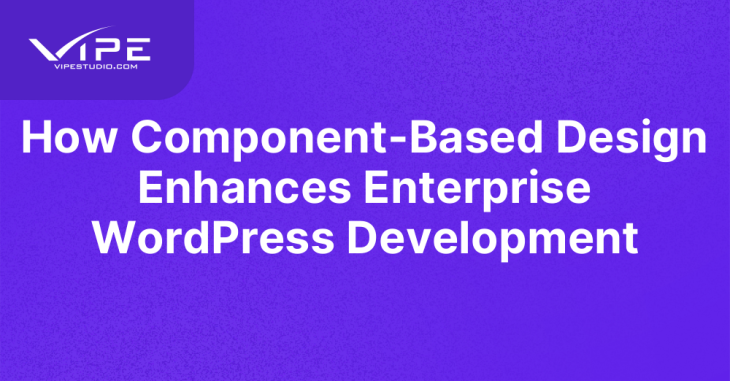How Component-Based Design Enhances Enterprise WordPress Development

READING TIME: MIN
As digital platforms grow in size and complexity, maintaining consistency and scalability becomes a key challenge—especially for enterprise WordPress websites. Component-based design, a concept popularized in modern frontend development, offers a practical solution. By structuring interfaces as reusable components, organizations can accelerate development, reduce maintenance, and ensure design consistency across digital properties.
Understanding the Shift Toward Modular Frontend Architecture
Component-based design breaks down the user interface into modular, reusable blocks—such as buttons, forms, headers, and content cards. Instead of creating pages from scratch, developers assemble interfaces using predefined components. This philosophy aligns naturally with modern frontend libraries like React, Vue, and Next.js, which are often used in headless WordPress implementations.
Enterprises leveraging WordPress as a headless CMS can fully utilize this approach, separating content management in the backend from visual presentation in the frontend. The result is cleaner code, a faster design-to-development process, and improved user experience.

Why Enterprise Teams Are Embracing Component Libraries
Creating and maintaining a centralized design system or component library offers many benefits for enterprise teams:
- Consistency across all pages and apps: Every component adheres to the same design rules and interaction patterns.
- Faster onboarding for new developers: Team members can quickly use existing building blocks instead of writing new code.
- Scalable development workflows: Teams working on different parts of the platform can reuse shared components without duplication.
- Design and development alignment: Designers and developers collaborate more efficiently using standardized components.
At Vipe Studio, we regularly build custom React component libraries for enterprise clients using WordPress as a headless backend. This approach has consistently delivered faster time-to-market and fewer regressions.
Integrating Component-Based Design into the WordPress Ecosystem
Even in traditional (non-headless) WordPress setups, component principles can be introduced using block-based themes with the Gutenberg editor. WordPress’s block editor encourages modular content creation, where each block acts as a visual component. For example:

- Custom Gutenberg blocks for testimonials, pricing tables, and interactive widgets
- Reusable block patterns that editors can insert into pages quickly
- Flexible layouts that adapt across devices using responsive design standards
This blurs the line between design and content management, giving enterprise editors more freedom without compromising UX or codebase integrity.
Performance and Maintenance Benefits of Reusable Components
Component-based systems allow for easier debugging, optimization, and performance monitoring. If a component has a bug or needs a style update, changing it once automatically updates it across all instances. This reduces technical debt and improves quality assurance workflows.
Moreover, enterprise teams can optimize each component individually—lazy-loading only what’s needed, deferring expensive assets, and caching rendered output for faster performance.

Best Practices for Implementing a Component-Based Strategy
To successfully apply component-based design in a WordPress enterprise project, follow these best practices:
- Establish a design system early and define naming conventions for all components.
- Use tools like Storybook to document components and preview them in isolation.
- Integrate version control and CI/CD for your component libraries, especially in headless environments.
- Involve both designers and developers in the component creation process.
If you’re transitioning toward a more modern frontend architecture, these foundational elements will accelerate delivery and reduce rework in the long term.
Conclusion: A Smarter, Scalable Way to Build WordPress Frontends
Component-based design is more than just a technical trend—it’s a scalable strategy that empowers enterprise teams to build, maintain, and evolve digital products with confidence. Whether you’re using headless WordPress or traditional Gutenberg blocks, applying a modular philosophy will enhance both the developer experience and end-user satisfaction.

Ready to implement component-based design in your WordPress enterprise platform? Get in touch with Vipe Studio to explore tailored solutions for modern, modular development.
More on The Topic
- Multisite Madness: When One Install Rules an Entire Empire
- How WordPress Shapes Digital Democracies One Site at a Time
- The One-Page Website Comeback: Minimalism as a Business Strategy
- Security Theatre: The Myths We Tell Ourselves About WordPress Safety
- The Hidden Economy of Plugins: Who Really Controls WordPress?

